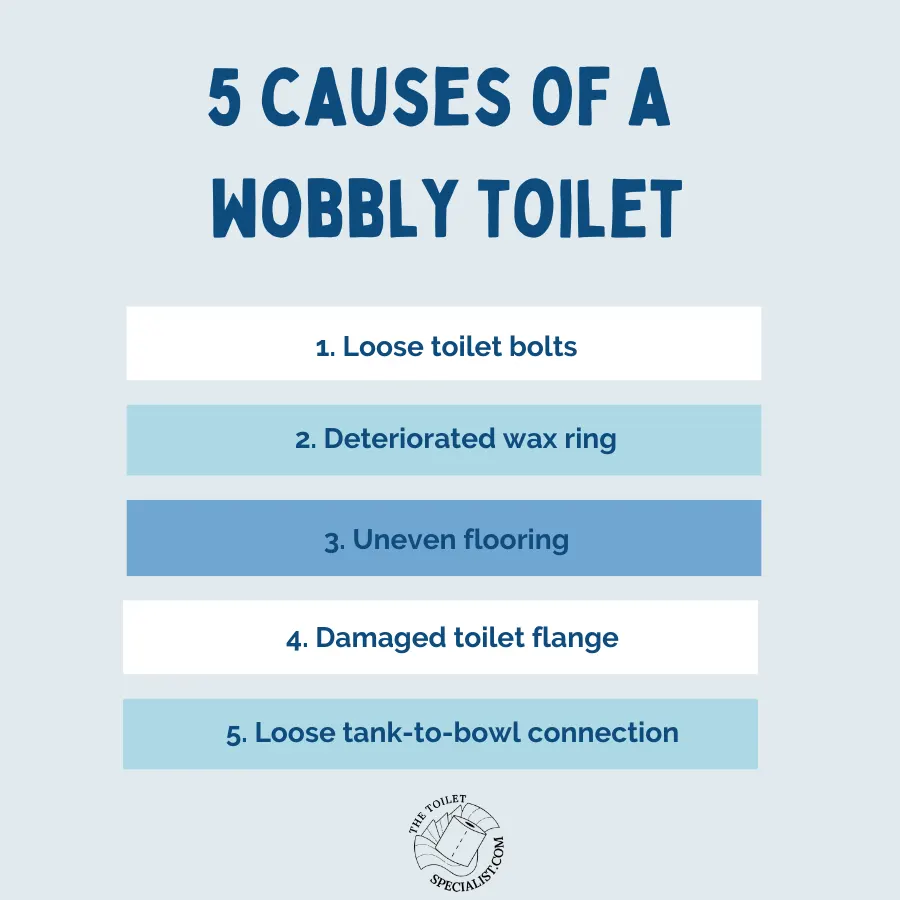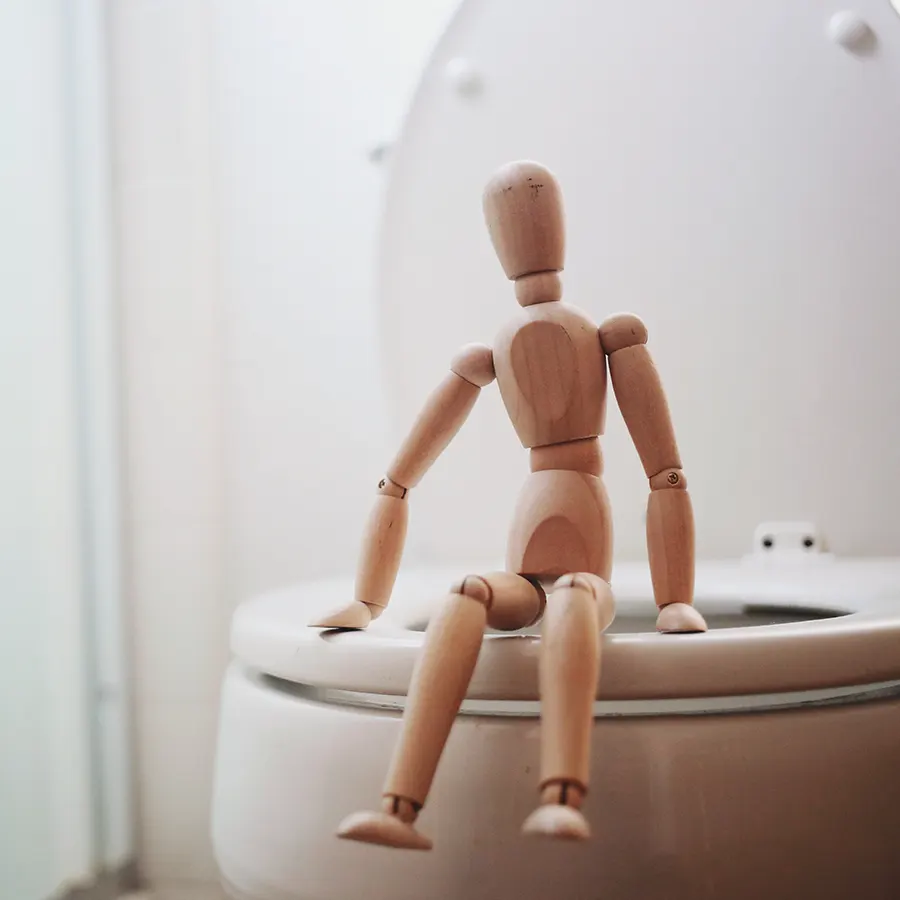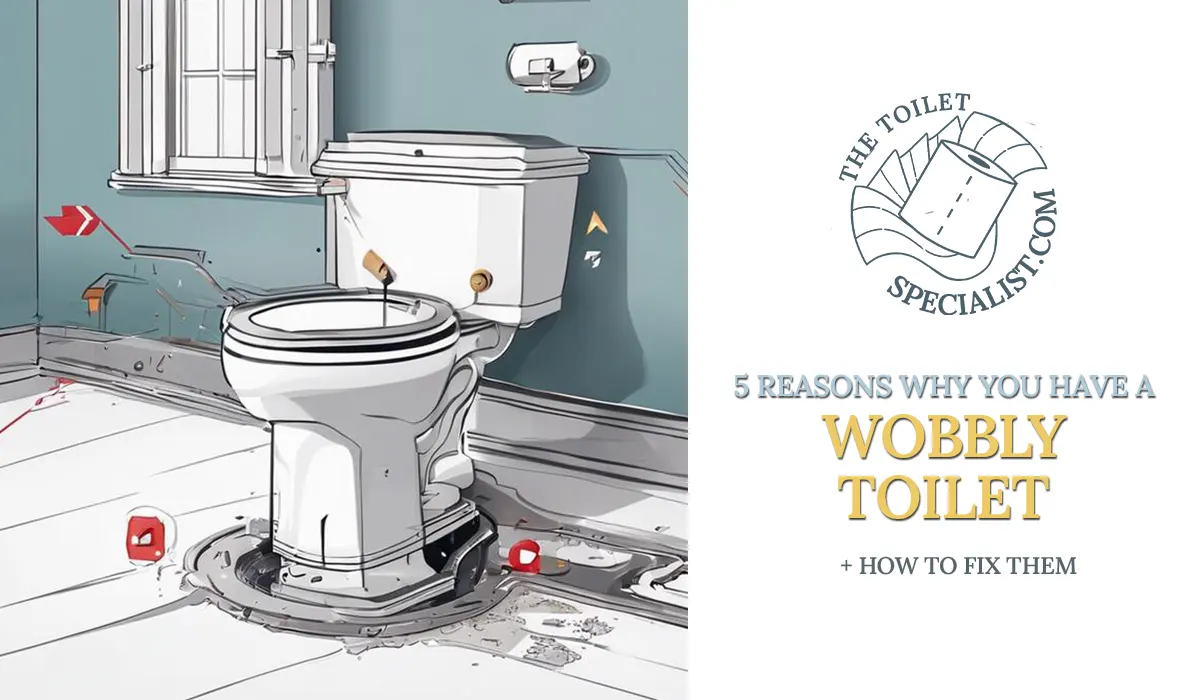Sitting on a toilet shouldn’t cause it to rock. However, if it does, there are easy ways to fix it yourself. But first things first: What to do when your toilet rocks?
When your toilet wobbles or rocks you should first identify the root cause. This could range from a deteriorated flange, and uneven floors, to simply loose bolts. Then, you decide whether to fix it yourself or have it be done by a professional. Luckily most causes of a wobbly toilet can be fixed without the help of a professional.
Don’t let a wobbly toilet throw you off balance! Keep reading to find out how to fix this issue yourself. Even when you’re not that handy!
Reasons why a toilet rocks
Every homeowner’s nightmare is a wobbly or rocking toilet. It’s not just uncomfortable and potentially embarrassing. It’s also an indication of a significant underlying issue that requires immediate attention.
So, why does my toilet move side to side? Let’s examine the most common causes.
1. Loose toilet bolts
The first and most common reason is loose toilet bolts. These bolts secure the toilet to the floor and are integral to its stability. Over time, these bolts can wear out or get loose. While it might seem like a minor problem, it can become a significant issue if not addressed promptly.
Tighten the loose bolts to fix your wobbly toilet. However, don’t overtighten them as it can leave you with a cracked toilet.
2. Deteriorated wax ring
Improper, deformed, or deteriorated wax rings can also cause instability. The wax ring sits between the toilet and flange, ensuring a tight seal to prevent leaks. Over time, these rings can deteriorate or become improperly seated, causing a shaky foundation.
Replace your wax ring with a new one to fix your rocky toilet. This particular wax ring is a bestseller and is top rated.
3. Uneven flooring
Uneven flooring is the third cause of a rocking toilet. Bathrooms, like any other parts of your home, are susceptible to settling and shifting subtly over time, leading to flooring variances. If the floor on which the toilet sits isn’t level, expect your toilet to rock.
Use plastic shims to fill in any gaps underneath your toilet. Then, cut them and go over it with a color-matching caulk. This should fix the wobbliness of your toilet.
4. Damaged toilet flange
Your toilet flange has bolts (you know the ones we talked about earlier) that are held by a ring. If this ring is damaged you can tighten the bolts all you want but they just won’t be secure.
To fix this, you should replace your toilet flange. You can use this top-rated replacement flange.
5. Loose tank-to-bowl connection
If the bolts connecting the toilet tank to the bowl are loose, it can contribute to wobbliness.
To fix, tighten these bolts. But don’t over-tighten them as it may crack your toilet.
Now that you know the common sources of instability in a toilet, you can try to fixt them yourself. If you are not comfortable doing that, the next step is to consult a professional plumber. Not only does he provide a solution, he assesses the issue so you will 100% know what the issue is.
Worried about the costs? Check out this list of general plumber costs.

Fixing a wobbly toilet yourself
To begin troubleshooting a wobbly toilet, it’s imperative to be equipped with the right set of tools and safety measures. Ensuring that you’re prepared not only simplifies the process but also protects you from potential dangers. So, let’s delve right into the specifics!
Tips to prepare for working on your toilet
Working with a potentially damaged toilet, water supply, and sewage lines can be a messy affair. To mitigate this, a bucket and sponge or towel should be within arm’s reach for easy clean-up.
Turning off the water supply should be your first step before diving into the nitty-gritty of toilet repairs. This helps avoid accidental flooding and gives a dry space to perform the necessary repairs. Once done, flush the toilet several times to empty the tank and bowl.
Always consider ventilation when working with toilets. The enclosed environment can often contain potentially harmful substances. Open any nearby windows and doors, turn on a fan, or consider wearing a mask if necessary to avoid inhaling fumes.
While working with the toilet, be conscious not to over-tighten the bolts. This can break the porcelain, leading to leaks or even the need for a completely new toilet.
Don’t overlook the safety measures involved. They’re there to ensure you can effectively bring a steady end to your toilet woes, without any unwelcome surprises or hazards.
Remember, sometimes calling in a professional plumber can be the best solution, especially when the task seems overly complicated or risky.

Step-by-step guide to fix a rocking toilet
The following steps are a general guide to how to check and fix your wobbly toilet.
1. Inspection and toilet removal
- Inspection
- Begin with a thorough examination of the toilet bowl and tank. Observe any signs of damage that could be causing the instability – cracks, worn-out gaskets, etc. This will give a clear picture of where the attention is needed most.
- Toilet Removal
- If the issue persists despite efforts to tighten bolts and have a properly installed flange, it might be worthwhile to remove the toilet for a more comprehensive inspection. To do this, drain the toilet and disconnect the water supply. Then, remove the caps and nuts before gently lifting the toilet to expose the flange and wax ring.
2. Examination of the most common causes
- Flange Examination
- Once the toilet is removed, it becomes easier to scrutinize the flange. This is important in determining whether a replacement is necessary. Also, clean around the flange area to ensure it’s free from old wax, grime, or any debris.
- Replacement of Wax Ring
- Once any necessary repair or replacement of the flange is completed, the next step is to replace the wax ring if necessary. Place the new wax ring where the old one sat, and replace the toilet.
3. Reinstallation and finish
- Reinstallation of Toilet
- Carefully place the toilet on top of the new wax ring, making sure it lines up correctly with the bolts. Apply slight pressure to allow the wax ring to adjust and form a seal. Replace and tighten the nuts – remember not to over-tighten them.
- Water Supply Reconnection
- Finally, connect the water supply line back to the toilet. Allow the tank to fill before flushing to ensure the rocking issue has been resolved.
- Caulking
- Apply the caulking around the base of your toilet (but leave the back uncaulked). This not only improves the toilet’s aesthetics but also makes it easy to spot any future leaks since the water can get out through the backside.
That’s it! However, one should not hesitate to reach out to a professional if the task seems too daunting or complex. If in doubt, just call your plumber.

Ultimately, by following this step-by-step guide, you can ensure your toilet is stable, safe, and can stand the test of time. So grab your wrench, putty knife, and shims, and let’s put an end to the shaking once and for all.
FAQs about a rocky toilet
Is it safe to use a wobbly toilet?
It is not unsafe to use a wobbly toilet but you should address the issue as quickly as possible, as you don’t know the cause of it (yet).
What does it mean if your toilet wobbles?
If your toilet wobbles it means that your toilet, when sat upon, rocks and feels unsteady. This can have many causes including uneven flooring or a damaged flange.
Is a wobbly toilet bad?
A wobbly toilet, depending on the issue, can be bad in terms of plumber costs. If it’s just a matter of loose bolts you can simply tighten them yourself. But sometimes the flange must be repaired which you can also do yourself, but if you’re not that handy you should call a plumber. This can add up in costs which makes a wobbly toilet bad.
Disclaimer: TheToiletSpecialist.com is not responsible for any damage caused to your toilet and surroundings by (wrongly) interpreting information found on this site. Please seek custom advice from a professional to evaluate your current situation.
This article may contain affiliate links at no extra cost to you. AF links help support this blog so that it can exist and expand for years to come!





